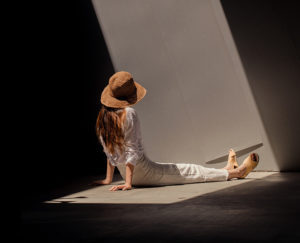
September 09, 2020 at 10:14AM

Why is it so hard for most of us to rest? We’re not sure we’ll get to the bottom of that self-care quandary in just one story, but lately, you may have noticed we’re chipping away at the topic more and more with stories focused on our mental and emotional health.
One incredible tool in the pursuit of meaningful self-care is yin yoga.
While most modern yoga classes are about achieving a good sweat and getting into a ‘flow’, yin yoga incorporates long-held passive postures that allow energy to reach deep connective tissues. These deep, long stretches result in a variety of mental and physical health benefits that have to be experienced to be understood. Yin yoga is a slow-paced, meditative style of yoga that greatly contrasts from ‘yang’ styles like Ashtanga or Vinyasa.
To explore the topic of yin yoga in full, we talked to Alana Kessler, a yogi, registered dietician and holistic wellness pro who offers a Yin Yoga and Mindfulness Immersion Training we’re scheduling into our weird Fall 2020 schedules.
ADVERTISEMENT
ADVERTISEMENTKate Spade Autumn/Winter Sale |
We wanted to break down a few basics about Yin Yoga first and have scheduled this series of stories with Alana to help us all understand the basics…
The Chalkboard: What Are Yin Exercises in Yoga? And what are our ‘yin tissues’?
Alana Kessler: ‘Yin’ means receptive and restorative, while ‘Yang’ means dynamic and generative.
In general, the yin tissues of the body are the stabilizing connective tissues of the body. They are the ligaments, the joints and the tendons. They offer structural support as well as a boundary so that our bones stay safe and we don’t go too far physically and energetically.
Yin tissues respond to gravity through compression and pulling. Its called tensegrity. By aligning your bones into a posture, you will compress the spine, bone or tarsals such as saddle or seal ( which are backbends) or pull on the spine, ligaments and tendons by practicing postured like butterfly, caterpillar and sleeping swan (forward bends)
TCM: In contrast, can you explain the ‘yang tissues’?
AK: Yang tissues are dynamic tissues like muscle fibers and they offer movement and the ability to contract and constrict. When the yin tissues are exploited due to lack of awareness, repetitive stress, or age, the muscles begin to take on the role of stabilizers — which is why we feel tightness and can get tears.
TCM: So, neglecting the ‘yin tissues’ can be dangerous — and sounds very similar to the idea of ‘aging’. How do we better care for both our yin and yang tissues?
AK: Yang tissues need rest and stretching. To care for yang tissues, we need to include more yin activities.
Muscles and connective tissue both need to remain elastic and pliable but the way they achieve those states are different. Muscles stay healthy through short contractions and dynamic movements, whereas connective tissues remain elastic through long held passive postures where we compress and pull the tissue to its edge while breathing intentionally.
TCM:What should people expect from yin yoga class? Isn’t it often an emotional experience — can you explain that?
AK: In a yin class, you can expect to be holding postures close to the ground for 3-5 minutes. There isn’t much “flow” except to move from one posture to the next. It is an exercise in mindfulness and is a beautiful meditative experience because of its tendency to trigger feelings of frustration, fear, boredom and uncertainty.
ADVERTISEMENT
ADVERTISEMENTSports Direct Free Delivery on All Orders! |
We often move too quickly in life, that moments of stillness can feel super uncomfortable. Yin yoga challenges that by inviting us to turn towards what we may not feel physically and emotionally.
My students often have emotional experiences during class because the postures begin to release the energetic blocks that are caught in our connective tissues.
We are physical and energetic beings. Our unfelt emotions get stored in our bodies — specifically the connective tissue. When we practice yin yoga, and allow, through compression and pulling, for the tissue to be released, the emotions get released as well.
TCM: Can you give me one great yin move that gives people that delicious yin yoga feeling at home to start?
AK: Yin yoga feels like a warm bath where you can feel your whole body.
One of my favorite poses is butterfly pose. The forward bend is very cooling and the pulling on the inner thighs helps to nourish the adrenals and help calm the nervous system.
To do the butterfly stretch:
+ Sit on the floor or with a cushion underneath you if needed with knees faced outward and the soles of your feet pressing into each other.
+ To deepen the intensity, move your feet closer in toward your hips.
+ Elongate and straighten your spine, tucking your chin in toward your chest.
+ Breathe. With each inhale, lengthen your spine and feel the line of energy extending out through the top of your head.
With each exhale, fall heavy into the floor and relax or sink a bit more deeply into the stretch.
+ Hold this position for up to 2 minutes. Repeat 2 to 4 times.
ADVERTISEMENT

ADVERTISEMENT
Anya Hindmarch - I AM A PLASTIC BAGThe post Learning To Rest: On The Healing Power of Yin Yoga with Alana Kessler appeared first on The Chalkboard.
Continue Reading…
Author The Chalkboard | ChalkBoardMag
Selected by CWC
ADVERTISEMENT
ADVERTISEMENTUp to 30% off Gift Sets |






